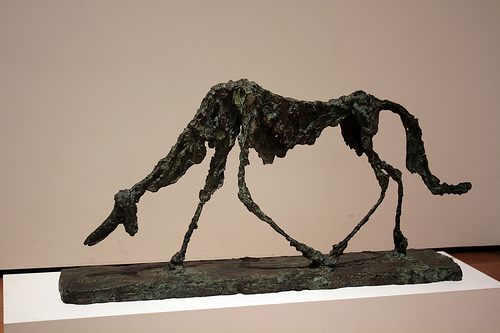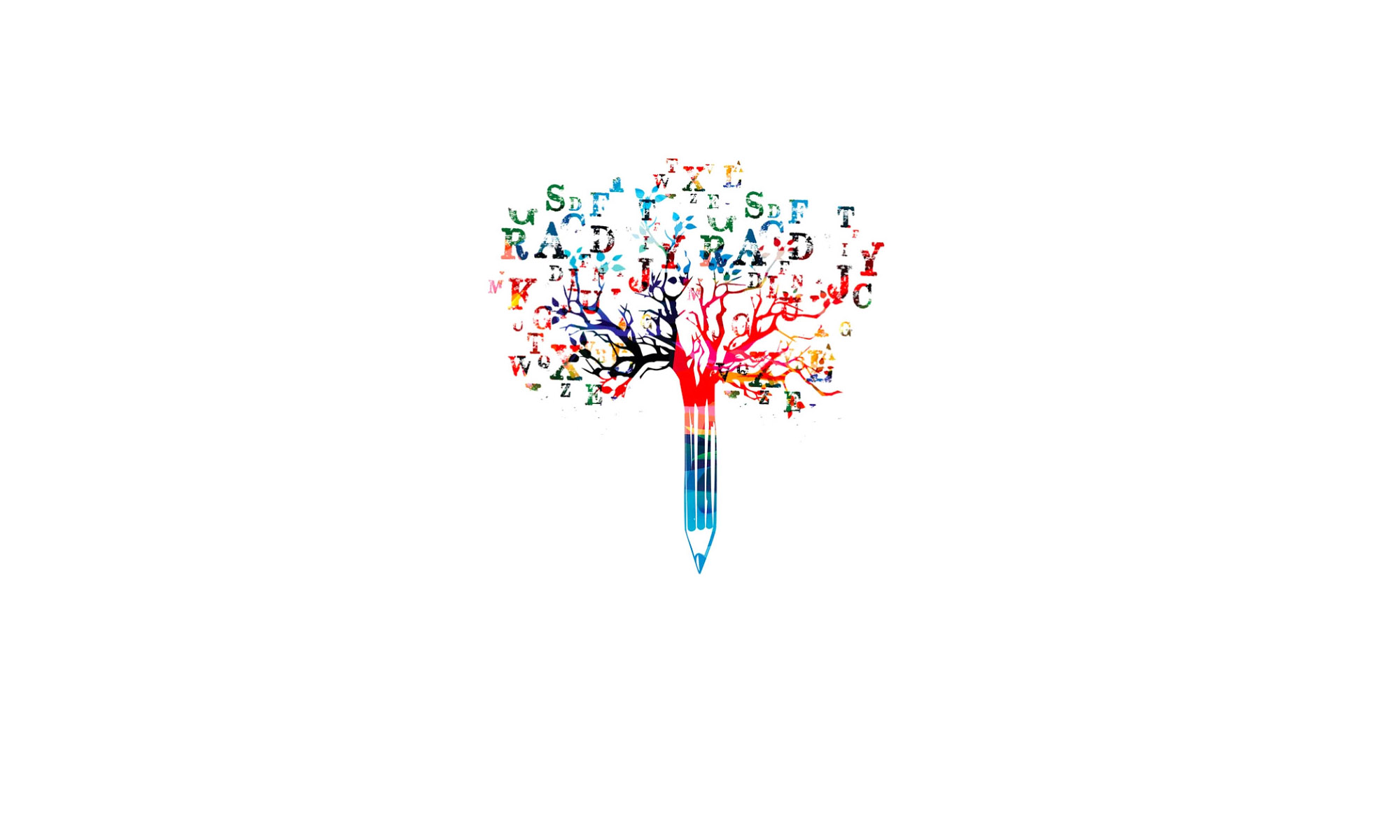“Sculpture has the longest memory of the arts: from the Paleolithic era, we find stone carvings and clay figures embedded with human longing. And poets have long been fascinated by the idea of eternity embodied by the monumental temples and fragmented statues of ancient civilizations. From Keats’s Grecian urn and Shelley’s “Ozymandias” to contemporary verse about Maya Lin’s Vietnam Veterans Memorial and Janet Echelman’s wind-borne hovering nets … ” (Robert Pinksky, Forward to Poems About Sculpture, 2016)
Looking at sculpture is an interactive experience. It gives you, the viewer, an ‘up close and personal’ experience of the material used, the sculpture’s shapes and spaces, it’s ‘movement’, it’s character, it’s changing nature when viewed from different angles. The sculpture not only interacts with the viewer, but with its surrounding space. The way a sculpture is displayed is also important to the experience: is it behind glass? On a pedestal? On the floor? Mounted on a wall.?
All of these factors affects your experience of the artwork. In turn, the poet must find ways to reflect these same experiences of the sculpture. Let’s have a look at three of these and their translation to the written page.
The first poem that we will consider is Shelley’s ‘Ozymandias’, a notional (fictional) ekphrasis that considers the tradition of erecting monuments to tyrants in the context of the ravages of time (in this case, a desert). All we know about Ozymandias as an historical figure is that the name is probably a corruption of the name of Ramesses II as it appeared on the stone reliefs in the mortuary temple complex.
Ozymandias (Percy B. Shelley)
I met a traveller from an antique land,
Who said—“Two vast and trunkless legs of stone
Stand in the desert. . . . Near them, on the sand,
Half sunk a shattered visage lies, whose frown,
And wrinkled lip, and sneer of cold command,
Tell that its sculptor well those passions read
Which yet survive, stamped on these lifeless things,
The hand that mocked them, and the heart that fed;
And on the pedestal, these words appear:
My name is Ozymandias, King of Kings;
Look on my Works, ye Mighty, and despair!
Nothing beside remains. Round the decay
Of that colossal Wreck, boundless and bare
The lone and level sands stretch far away.”
From the very first lines, we know that this sculpture was not experience first-hand, but by the word of the ‘traveller from an antique land’ (most likely Egypt). This creates a distance between speaker and sculpture; the narrative is entirely from the point of view of the traveller, who gives a damning description of the sculpture (Kranz might call it a ‘pejorative’ stance). We know only that there are two ‘vast legs’, all that is left of the magnificence that must have been an imposing palace and a mighty kingdom. But here we see it in a new context: not in ‘situ’, not in a museum (like the Pergamon Museum in Berlin, which houses many exquisite artefacts from that region), but in a desert, in the context of decay and abandonment from where ‘the lonely and level sands stretch far away’. The poet has used context to set up a stark contrast between the arrogance and assumptions of the tyrant (whose ‘wrinkled lip and sneer of cold command’ demand respect) and the effects of time and change on even the most powerful. Notice Shelley’s brilliant use of capital letters only for titles such as ‘King of Kings’ and ‘ye Mighty’ and then….’colossal Wreck’, a wonderful drawing together of these polar opposites -making his final point that even the ‘mighty’ will decay and disappear.
It’s interesting to add here that the text stamped on the pedestal is an example of the way that words, inscriptions, and titles on any artwork expand the meaning of it – and in this case the combination of the ‘trunkless legs’ and the powerful words of a tyrant give the poem an entirely different significance than if it had only described the object on its own. *
*(Note: this is why many artists refuse to give titles to their artworks. One of these is Clyfford Still of the Abstract Expressionist Movement).
Let’s move on to a sculpture that is displayed in the context of a museum (in this case, The Museum of Modern Art, New York). Alberto Giacometti’s ‘Dog’, is a much-loved sculpture of a scrawny and emaciated dog who seems to be barely able to stand on his thin legs, let alone walk – as he does here. ‘Dog’ is the canine variant of Giacomettis’ “elongated, withered representations of the human form, including his 1960 sculpture Walking Man I. Giacometti’s severe figures explored the psyche and the charged space occupied by a single person. Linked to Jean-Paul Sartre and existentialism, they are seen as metaphors for the postwar experience of doubt and alienation’. (https://artsy.com)
Giacometti’s Dog

Alberto Giacometti
Dog
1951 (cast 1957)
Medium: Bronze
Robert Wallace’s poem ‘Giacometti’s Dog’ provides a wonderful study in the use of space and movement in sculpture. Here, we find a scrawny mutt going his own way, minding his own business, with no regard for the viewers who have come to admire the handiwork of his creator.
Giacometti’s Dog
Lopes in bronze:
scruffy,
thin. In
the Museum of Modern Art
head
down, neck long as sadness
lowering to hanging ears
– he’s eyeless-
that hear
nothing, and the sausage
muzzle
that leads him as
surely as eyes:
he might
be
dead, dried webs or clots of flesh
and fur
on the thin, long bones- but
isn’t, obviously
is obviously
traveling intent on his
own aims: legs
lofting
with a gayety the dead aren’t known
for, Going
onward in one place,
he doesn’t so much ignore
as not recognize
the well-
dressed Sunday hun-
dreds who passing, pausing make
his bronze
road
move. Why
do they come to admire
him?
They wouldn’t care for real dogs
less raggy
than he
is? It’s his tragic
insouciance
bugs them? or is
it that art can make us
cherish
anything- this command
of shaping and abutting space-
that makes us love
even mutts,
even the world, accept
even
the starry wheels by which we’re hurled
toward death, having
the rocks and
wind for comrades?
It’s not this starved hound,
but Giacometti seeing
him we see.
We’ll stand in line all day
to see one man
love anything enough.
Robert Wallace (
The first line of the poem sets the sculpture in motion . In the context of a distinguished museum of modernist art, MOMA, the dog seemingly ‘lopes’ through its grand context of display and its down-and-out appearance, which we see in the close-up of its materials (the dear, dried webs or clots of flesh) and careless attitude seem out of place here. Travelling with purpose, the dog takes on a life and character of its own. In contrast to the lifeless stone that we found in Shelley’s Ozymandias, the material here is given a vibrant quality, ‘a gayety the dead aren’t know for’. Indeed, by giving the viewer a sense that the dog is ‘going onward in one place’, we see not only the object but the success of the artist in creating motion in an inanimate object that is actually frozen in space. The dynamics created in the dog’s form is enhanced, in the poem, by the passing of ‘the Sunday hundreds’, as it is also their motion which makes him seem to move: it is the result of active viewing, of walking around the object in its space of display. This sense of movement is achieved structurally by the poet’s use of irregular line-length, lines which are as uneven as the dog’s pace seems to be; you can almost see him walking hesitantly, stopping to sniff here and there, continuing slowly on his way …. Here we have a poem that not only describes its object but also attempts to imitate certain aspects of it (or, in ekphrastic terms, uses analogous structuring). Aside from describing and imitating the object, Wallace brings in the question of art itself (in ekphrastic terms: Association). In asking what it is about Giacometti’s dog that entrances so many hundreds of people, we enter a discussion of its value as an artwork. Is it the dog’s ‘insouciance’ (indifference) that ‘bugs’ them, because they want to ‘possess’ the artwork somehow? Or is it that art can raise the ordinary to the aesthetic or beautiful, which is more of a fascination with, not the object, but the artist’s skill in creating such an intriguing mutt? Or is it that even our common fate can be made beautiful if raised to the level of art, through the artist’s ‘command/ of shaping and abutting space -/ that makes us love/ even mutts,/ even the world, accept/ even the starry wheels by which we’re hurled/ toward death …’?
Many of the questions raised by Wallace are often ones that we might ask ourselves when we are intrigued by a work of art: What does it mean? How can I relate to it? How did the artist do that? Is the desire to possess the ‘indifferent’ artwork the reason why we buy postcards at the museum store? Or is it simply because we would ‘stand in line all day to see one man love anything enough’?
Moving from this wonderful modernist representation of an ‘everyday mutt’, I would like to turn to a more sober reflection of our society, created by Saint-Gauden’s memorial to Robert Shaw and the 54th Regiment and Robert Lowell’s poem to the artwork, ‘For the Union Dead’. These two works are important to the study of the impact of place (context) on the meaning(s) of an artwork. Below is the bronze relief memorial to Robert Shaw and his troop of black soldiers, who bravely fought and died in the cause of abolition. Their young officer, Robert Shaw, died with the 180,000 black soldiers during the last two years of the civil war,

Saint-Gaudens: Shaw Memorial, 1865
The Robert Gould Shaw and Massachusetts 54th Regiment Memorial, which is located across from the State House, serves as a reminder of the heavy cost paid by individuals and families during the Civil War. In particular, it serves as a memorial to the group of men who were among the first African Americans to fight in that war. Augustus Saint-Gaudens’ bronze relief honours the bravery and sacrifices of the Massachusetts 54th – depicting the Regiment’s march down Beacon Street as they left Boston to head south and into battle.
Robert Lowell’s poem “For the Union Dead” is both a celebration of the bravery of these troups and of their young, patrician officer, Robert Shaw. It is also an elegy for what Lowell sees as modern society’s lack of heroism and selfless nobility. The sculpture’s context of display – and the setting of Lowell’s poem – is a construction site near Boston Common, where steam-shovels are ‘dinosaurs’ and the modern world ‘slides by on grease’.
Note: Because of strict copyright laws, I cannot publish the poem here, but refer you to The Poetry Foundation’s website: https://www.poetryfoundation.org/poems/57035/for-the-union-dead
When you read the poem, pay attention to how the poet uses ‘context of display’ and the thought-provoking images to contrast the two worlds: the past and the present. This is a ‘contextual ekphrasis’ if there ever was one. Consider how the meaning of the poem would change if the Lowell had not chosen the wider perspective and had only described the sculpture.
Next Entry: A Christmas Greeting
